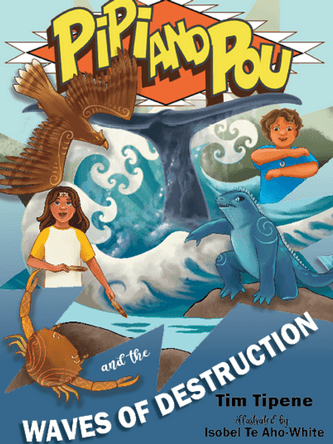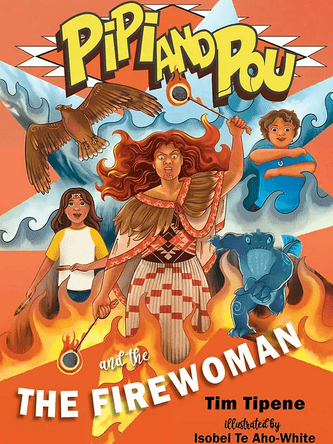Leila Austin joins two cousins with magical powers and their nana on their latest adventures dealing with floods, giant crabs and a furious fire goddess.

Pipi and Pou and the Waves of Destruction (Pipi and Pou #5) and Pipi and Pou and the Firewoman (Pipi and Pou #6), by Tim Tipene, illustrated by Isobel Te Aho-White (OneTree House)
Pipi and Pou and the Waves of Destruction and Pipi and Pou and the Firewoman are the latest in Tim Tipene and Isobel Te Aho-White’s Pipi and Pou series for junior readers. If, like me, you’re new to the series, think Captain Planet, but instead of a bunch of teenagers and a magical blue guy, it’s two plucky Māori kids and one exceptionally badass Nana, with their adventures firmly based in Aotearoa. In keeping with the after school cartoon vibes, Pipi, Pou, and Nana are engaging, larger than life characters. Nana brings experience, wisdom, and leadership, and is accomplished at forging bonds with supernatural entities. She also bakes a mean feijoa cake. Her two mokopuna, Pipi and Pou, are feisty and competitive and have secret magical powers: Pipi can transform into a pouākai, and Pou into a taniwha. The three work together as kaitiaki to guard and protect the natural world.
Pipi and Pou and the Waves of Destruction follows Nana, Pipi, and Pou to the east coast, where severe flooding has wiped out an entire town. Nana suspects a supernatural cause, and that the kaitaiki might just be able to save the day. The story is full of action, and features environmental themes, epic superhero antics, and a giant crab who might be as keen to eat our protagonists as he is to help them. There are some nice messages about the importance of speaking up and taking action to stop environmental damage, because, as local kaumātua Hone points out, “People have to understand that everything is interconnected. One problem leads to another.”
…think Captain Planet, but instead of a bunch of teenagers and a magical blue guy, it’s two plucky Māori kids and one exceptionally badass Nana, with their adventures firmly based in Aotearoa.
In Pipi and Pou and the Firewoman, Pipi and Pou’s cousin Rāwiri is recklessly playing with matches in a dry forest when a mysterious old woman turns up and throws a fireball at him. Pipi, Pou, and Nana set out to investigate, only to meet the fire goddess Mahuika, who is full of rage and vengeance and ready to burn them to a crisp. But it turns out they might have more common ground than Pipi, Pou, or Mahuika expected, and Nana, armed with a cuppa and some delicious feijoa cake, might be exactly the person to help them find it. There’s not as much action as the previous book, but the story more than makes up for it with extra humour and banter. (I especially enjoyed Pou’s attempts at chatting about selfies and online streamers to an ancient fire goddess.) Like Pipi and Pou and the Waves of Destruction, the story prominently features environmental themes—especially around taking care of the forest and being careful with fire—and a broader message about how looking after the natural world and looking after each other are inextricably tied together.
Both books are brimming with te ao Māori, prominently feature Māori mythology, and are liberally sprinkled with te reo words and phrases. I was impressed by how thoughtfully all of this has been woven into the text: if you’re well steeped in te reo and te ao Māori already, it adds an extra layer of familiarity to the characters and their world, but if you’re a newcomer, the context clues are strong enough that you’re unlikely to be lost. Pipi and Pou and the Firewoman also features a glossary of Māori words and phrases for good measure. Isobel Te Aho-White’s illustrations pair well with the text, combining cartoon boldness and Māori motifs, plus some recognisable bonus details here and there, like Nana’s cat napping sprawled over the back of the couch and a classic small town shop awning saying Nothing Over $2.
…looking after the natural world and looking after each other are inextricably tied together.
I felt that a few aspects of the books might have benefitted from a little more polish. The covers are very busy, which could potentially make them look a little cheap when surrounded by higher budget international competition, and the writing veered into clunky territory at times. (‘Said’ is a perfectly decent verb, ok? You don’t need a dictionary’s worth of synonyms for it. I will die on this admittedly nitpicky hill forever.) There were also a couple of quips from adult characters about dieting and avoiding cake in Pipi and Pou and the Firewoman which felt unnecessary for me. I don’t think diet culture belongs in a children’s book (or anywhere, to be honest) and it felt especially out of place next to Nana’s warm hospitality, which plays a crucial part in making peace with Mahuika. At one point Nana confidently proclaims, “Sometimes the only thing that makes sense in the world is cake.” I am with you wholeheartedly on that one, Nana.
But there’s so much charm on offer here too: lots of humour and banter, the warm, loving relationship between Nana and her mokopuna, the way Pipi and Pou might be secret superheroes, but they’re also a couple of snarky kids prone to bickering in the back seat of Nana’s old car. Speaking of, even the car has personality: she has an ever-changing name—Betsy, currently—and she likes to be sung to life with a waiata at the start of a journey. However, it’s Nana who really steals the show. She’s stubborn, funny, wise and powerful, but not infallible, especially in Pipi and Pou and the Waves of Destruction, where she has moments of doubt and gets relatably grumpy about water in her gumboots. The text layout is clean and spacious in both books, and there’s action from the first page, making them a solid option for six- to nine-year-olds just finding their feet with chapter books, with potential to entice reluctant readers too. They’re technically books five and six in the series, but you don’t need to run around tracking these ones down in numerical order. Each story is fully self-contained and easy to follow, with a brief, collector card style introduction to the three main characters at the beginning.
…there’s action from the first page, making [both books] a solid option for six- to nine-year-olds just finding their feet with chapter books, with potential to entice reluctant readers too.
The stories touch on challenging issues, but they’re unfailingly upbeat and optimistic, and every bit as fast moving and joyful as you want a superhero story to be. And how often do Māori kids get the chance to see themselves and their whanau depicted as superheroes? And in books that are unapologetically fun? Nowhere near enough, I reckon. Also, while the books have big cartoon hero energy, it’s worth pointing out that neither of these stories really has villains, just characters the protagonists are yet to find common ground with. I appreciated how Nana, Pipi, and Pou solved problems by treating the people and environment around them with honour, respect and kindness, and by finding kinship rather than using violence.
“‘The new generations care, and they listen, whaea,’ the tohunga explained. ‘Mistakes have been made in the past. Once these youngsters understand their role as kaitiaki though, our world will be in safe hands. Us older ones have to show them the way, lead by example, and then they can educate us.’”
These stories feel like a case in point. I hope there are more to come.

Pipi and Pou and the Waves of Destruction (Pipi and Pou #5)
By Tim Tipene
Illustrated by Isobel Te Aho-White
Published by OneTree House
RRP: $22.00

Pipi and Pou and the Firewoman (Pipi and Pou #6)
By Tim Tipene
Illustrated by Isobel Te Aho-White
Published by OneTree House
RRP: $22.00

Leila Austin
Formerly a children’s bookseller, Leila Austin can now be found working in the many weird and wonderful libraries of Central Auckland (she managed to find a job that takes her to all of them). She loves fantasy novels, fancy tea, and going for long walks in pretty places.



